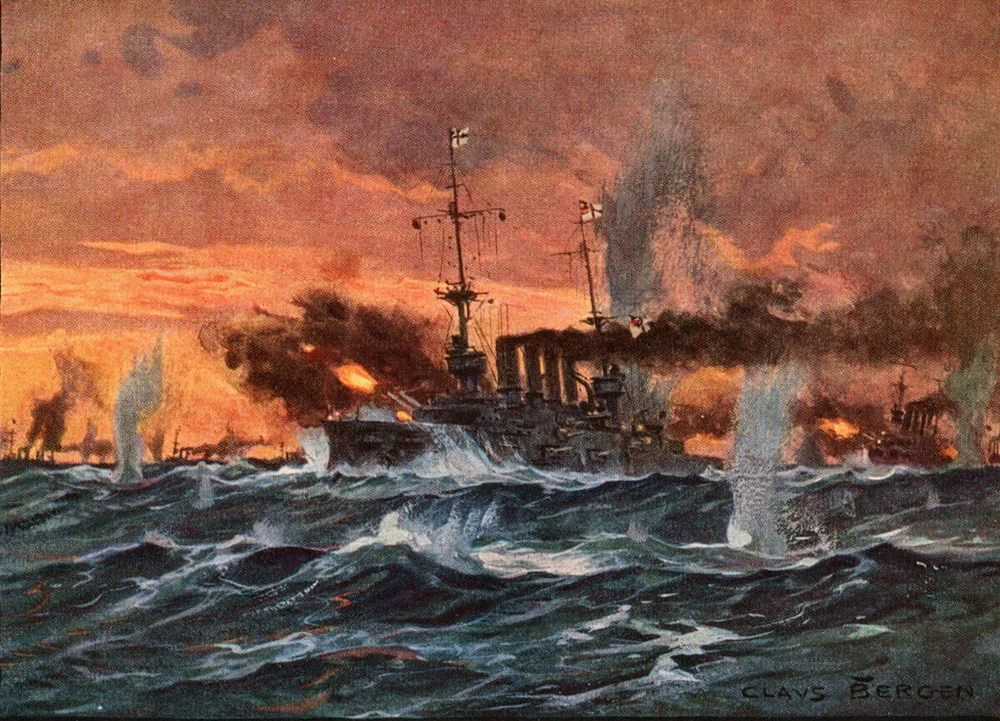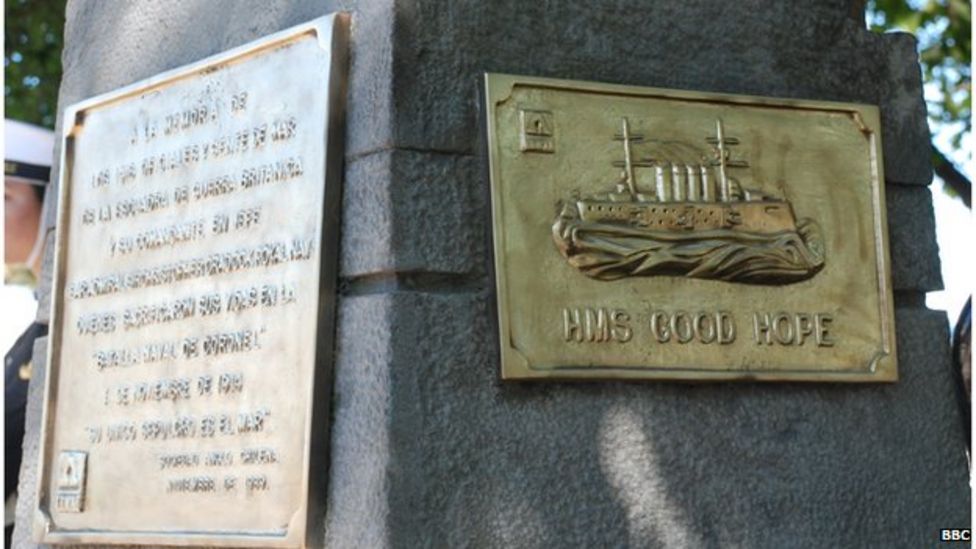Wallace Scott & The Battle of Coronel

On November 1st, 1914, HMS Good Hope was sunk in the Battle of Coronel with the loss of all hands, including our 3rd cousin, Able Seaman Wallace Scott (1884-1914). This tragic loss was symptomatic of the disfunction of the Royal Navy and Admiralty during the early months of Word War One. The Battle of Coronel was Britain’s first naval defeat since the Battle of Lake Champlain in the War of 1812.
Able Seaman Scott had been re-commissioned from the Royal Fleet Reserve (RFR) about the same time the HMS Good Hope had been re-commissioned from depot duty in mid-1914. Wallace had already served his five years of active service with the Royal Navy and transferred to the RFR in 1912.
Wallace Scott was the youngest of seven children born to Abraham Scott of Huby and Amelia Yeoman of Scoreby. By the time Wallace was born, the family had settled in Gate Helmsley, west of Stamford Bridge. Wallace moved to York to work as a gardener.
An Able Seaman had to be at least 20 years old with five years experience at sea. He was expected to have all the skills of an ordinary seaman and, in addition, be able to take over as the main helmsman, keeping the ship on course.
The National Archives
The trigger for joining the Royal Navy appears to have been the death of his first wife, Elizabeth Wilson, in September 1906, less than nine months after their wedding. Shortly thereafter, the newly widowed Wallace enlisted in the Royal Navy and by February 1907 was training on HMS Victory, Nelson’s flagship from the Battle of Trafalgar. Thereafter followed five years of uneventful naval service.
Having transferred to the naval reserve, Wallace returned to York, became a shoemaker like his father before him, and married his second wife Eliza in January 1914. They planned to start a family but Wallace was required to leave his pregnant wife upon his recall to active service at the outbreak of war. His son, Wallace Jr, was born in October 1914 while Wallace Sr was in the Falkland Islands, about transit around Cape Horn. It is doubtful that Wallace received news of his son’s birth before the Battle of Coronel.
The outdated and near obsolete HMS Good Hope, in the Reserve Fleet since 1913, was re-commissioned in mid-1914 with a crew composed mainly of naval reservists. After the Grand Fleet Review she was assigned to the 4th Cruiser Squadron across the Atlantic Ocean in Halifax, Nova Scotia. Upon arrival Rear-Admiral Sir Christopher Cradock transferred his flag to Good Hope and the squadron sailed for South America.
Receiving orders from the Admiralty, Cradock’s command moved further south to search for Germany’s East Asia Squadron, under the command of Vice Admiral Graf Maximilian von Spee, in the vicinity of Cape Horn and the Strait of Magellan. Failing to sight the enemy, Cradock sent two ships to continue the search up the west coast of Chile while Good Hope returned to Port Stanley in the Falkland Islands to re-coal and re-connect with the Admiralty.

The squadron was to be reinforced with the pre-dreadnought battleship HMS Canopus and the armored cruiser HMS Defence. Canopus had arrived in Port Stanley but required a major overhaul and was therefore left in the Falklands. Cradock returned to the hunt for Spee under the false assumption that the arrival of Defence was imminent, unaware the ship had been recalled to the Mediterranean.
Rounding Cape Horn and rejoining his squadron on the west coast of Chile, Cradock sent HMS Glasgow to Coronel to pickup messages from the Admiralty and collect mail. Glasgow delayed entry to Coronel for 24 hours due to German ships in the harbor, who alerted Spee to her presence. Spee departed Valparaiso to intercept Glasgow. However by noon, November 1st, Glasgow had rejoined Cradock and HMS Good Hope, HMS Monmouth, and Otranto. They formed a line abreast formation 15 miles apart and steamed north.
The squadron sighted Scharnhorst, Gneisenau and Leipzig and Spee ordered full speed so they were approaching the British at 20 knots, with the slower light cruisers Dresden and Nürnberg some way behind. Neither Admiral had expected this encounter. Cradock swung his squadron south and their fastest speed was determined the by the slowest vessel, Otranto, at 16 knots. The pursuit only lasted 90 minutes in the storm force winds and heavy seas.
Cradock should never have engaged Spee’s squadron but one of his fellow senior naval officers, Admiral Ernest Troutbridge, was in the process of a court martial for not attacking a clearly superior force. At 5:10pm Cradock turned his ships to close the distance to the German ships as they had greater range, leaving his squadron invisible to the enemy due to the blinding sun behind them. However Spee waited until the British ships were silhouetted by the setting sun and the the German ships were invisible against the rocky coastline. Once the German fleet was within 12,000 yards they began firing.
HMS Good Hope represented one of the worst and most expensive types of ship ever built for the Royal Navy in modern times. She was an immense target and much under-gunned for her displacement. The Monmouth, also of nearly 10,000 tons, carried no gun larger than a 6 inch.
The Times History of The Great War, 1922–1949

The German ships had sixteen 8″ guns compared the British ships two 9″ guns. Cradock closed within 6,000 yards of the German ships but as he closed, the German fire became correspondingly more accurate. Good Hope and Monmouth caught fire, presenting easy targets to the German gunners. As darkness fell the German ships disappeared into the dark and Monmouth was first to be silenced. Good Hope continued firing, continuing to close on the German ships and receiving more and more fire. By 19:50, she had also ceased firing; subsequently her forward section exploded, then she broke apart and sank, with no one witness to the sinking.
TheGood Hope, a shell must have hit the magazine – she blew up. TheMonmouth soon afterwards also blew up. Just before that, their guns – although they were sinking – their guns were firing and those men were carrying out their action stations right until the very last. There’s a darkening sky; there’s a leaden sea; the weather is getting gradually worse. And we were steaming south getting away out of it, our thoughts mixed, very mixed. Cursing because we couldn’t get to our pals to help them; glad to get away out of it. What could we do? Nothing, just nothing.
A. Bushkin witnessed the loss of theMonmouthfrom aboard HMSOtranto, Voices of the First World War:War At Sea, Imperial War Museum
With no survivors from eitherGood HopeorMonmouth, 1,660 British officers and men were lost, including Able Seaman Wallace Scott.GlasgowandOtrantoboth escaped. The German ships incurred no casualties.

Post Script
The Battle of Coronel was the result of a series of errors. Neither admiral expected to meet the other in full force. Once the two met, Cradock interpreted the Admiralty orders were to fight to the end, despite the odds being heavily against him. Although Spee had a relatively easy victory, destroying two enemy armoured cruisers, the engagement cost him almost half his supply of ammunition, which was irreplaceable.
This was a superpower being humiliated. This sort of thing just didn’t happen to the Royal Navy. It had a genuinely catastrophic impact on British morale.
BBC News, 1 November 2014
Shock at the British losses led the Admiralty to deploy more ships, including two modern battlecruisers, which in turn destroyed Spee and the majority of his squadron on December 8th at theBattle of the Falkland Islands. They sank four German ships, killing more than 1,800 sailors. All the British ships survived.
Wallace’s widow, Eliza, received a naval pension totaling 18 shillings / 6 pence per week (equivalent to £88 in 2023) to support Wallace Jr and Mabel, a daughter from a previous relationship. They remained in York and Eliza passed away, aged 87, in 1973.
Service Record

Memorials
On the 75th anniversary of the battle, a memorial to those who perished was erected in Coronel, Chile. Alongside two plaques depicting HMS Good Hope and HMS Monmouth, it has a central dedication plaque (in Spanish):
In memory of the 1,418 officers and sailors of the British military squadron and their Commander-in-Chief, Rear Admiral Sir Christopher Cradock, Royal Navy, who sacrificed their lives in the Naval Battle of Coronel, on 1 November 1914. The sea is their only grave.
Plaza 21 de Mayo, Coronel, Chile

The crews of HMS Good Hope and HMS Monmouth are also remembered on the Portsmouth Naval Memorial, in Hampshire, England.

Family Tree
The common ancestors we share with Wallace Scott & Alfred Maddison are our 5th Great Grandparents, John SCOT & Elizabeth BROWN, from Sutton on the Forest, Yorkshire. Our family line is descended from the eldest son John SCOTT. Wallace & Alfred’s lines are descended from the second eldest son, Robert Scott.
- John SCOT (1760-?) & Elizabeth BROWN (1768-?)
- John SCOTT (1786-1857) & Anne TAYLOR (1890-1878)
- Jane SCOTT(1828-1872) &Henry BAINBRIDGE(1831-1891)
- Charles BAINBRIDGE(1861-1935) &Elizabeth A HEADLEY(1863-1935)
- John Henry BAINBRIDGE(1892-1940) &Adelaide EDGAR(1888-1975)
- Charles R BAINBRIDGE (1915-1994) & Winifred May THOMPSON (1920-1977)
- Our direct line…
- Charles R BAINBRIDGE (1915-1994) & Winifred May THOMPSON (1920-1977)
- John Henry BAINBRIDGE(1892-1940) &Adelaide EDGAR(1888-1975)
- Charles BAINBRIDGE(1861-1935) &Elizabeth A HEADLEY(1863-1935)
- Jane SCOTT(1828-1872) &Henry BAINBRIDGE(1831-1891)
- Robert Scott (1787-1864) & Ann Lewis (1790-1851)
- George Scott (1815-1889) & Mary Anne Richardson (1819-1853)
- Abraham Scott (1840-1899) & Amelia Yeoman (1843-?)
- Wallace Scott (1884-1914) & Eliza Purvis (1885-1973)
- Mabel Scott (1908-1997) illegitimate
- Wallace Scott (1914-1987)
- Wallace Scott (1884-1914) & Eliza Purvis (1885-1973)
- Abraham Scott (1840-1899) & Amelia Yeoman (1843-?)
- Betty Scott (1819-1893) & Stephen Nelson (1814-1895)
- Rebecca Nelson (1846-1924) & John Regan Richardson (1847-1915)
- Hannah M Richardson (1873-1925) & James A Maddison (1877-1941)
- Rebecca Nelson (1846-1924) & John Regan Richardson (1847-1915)
- George Scott (1815-1889) & Mary Anne Richardson (1819-1853)
- Joseph Scott (1790-?)
- Thomas Scott (1793-?)
- Elizabeth Scott (1796-1887)
- Charles Scott (1798-1861)
- John SCOTT (1786-1857) & Anne TAYLOR (1890-1878)
References
- HMS Victory, Wikipedia
- Able Seaman (rank), Wikipedia
- Battle of Grand Hope, Wikipedia
- The Royal Fleet Reserve and How to Join It, RootsWeb
- HMSGood Hope(1901), Wikipedia
- The Royal Navy in Nova Scotia Waters “HMS Good Hope”, Nova Scotia Archives
- Battle of Coronel, Wikipedia
- Battle of Coronel, The Canadian Encyclopedia
- Battle of Coronel, Historica Wiki
- British Naval Disaster at Coronel, Warfare History Network
- The Battle of Coronel, November 1st 1914 – Part 1, Dawlish Chronicles
- A British naval catastrophe saw the sinking of the Good Hope and the Monmouth in 1914, Look & Learn
- Battle of Coronel, British Battles
- Voices of the First World War: War At Sea, Imperial War Museum
- Wallace Scott, Clements Hall History Group
- 2,447 died on this day: Sun 01/11/1914, FirstWorldWarOnThisDay
- HMS Good Hope (1901), Dreadnought Project
- HMS Monmouth (1901), Wikipedia
- HMS Canopus (1897), Wikipedia
- We Remember Wallace Scott, Lives Of The First World War, IWM
- Able Seaman Wallace Scott, Commonwealth War Graves Commission
- 2,447 died on this day: Sun 01/11/1914, FirstWorldWarOnThisDay
- Admiral Ernest Troutbridge, Wikipedia
- Battle of the Falkland Islands, Wikipedia
- The Battles of Coronel & Falkland Islands (1927): ‘The Spectators are Exhilarated’, Silent London
- WW1 Coronel: An unlikely naval battle remembered, 1 Nov 1914, BBC News
- HMS Good Hope 1901-1914, WreckSite






1 Response